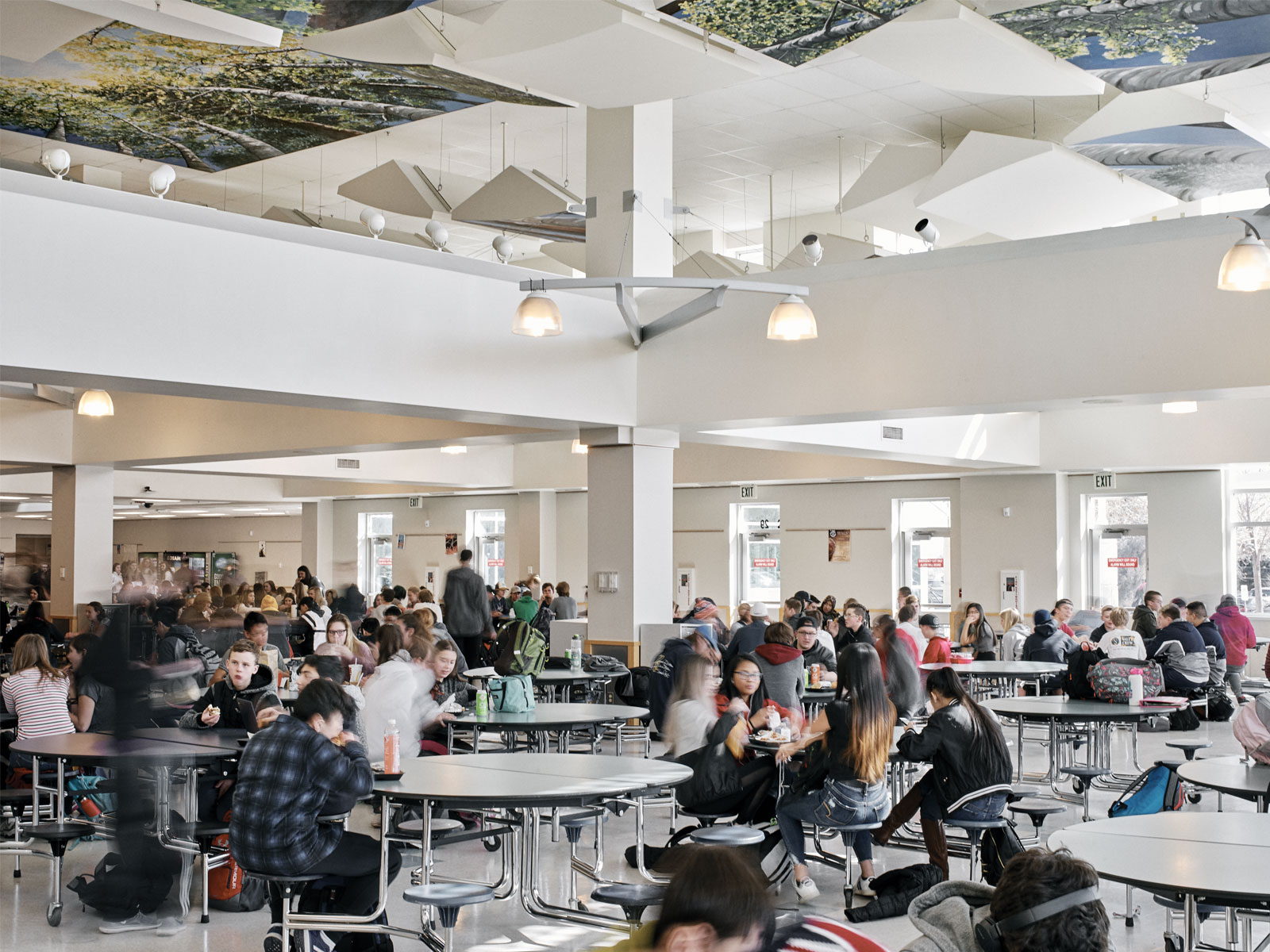“People outside this community know about us because of one moment in time.”
How a place beset by unspeakable violence and grief has redefined itself over the past two decades.
|This story begins on a slab of concrete in a quiet subdivision a few miles from Columbine High School, with two people staring at the car a teenage girl didn’t get to drive home. Beth Nimmo opens the driver’s door of her daughter’s vehicle and runs a hand over the cracked leather interior as if for the first time. There are many memorials around here, sacred places for a community where the past is also the present and the future. At the park next to the school, where summer softball teams still leave autographed balls at stone markers etched with the names of the 13 victims; at the neighborhood bar down the street, where the murdered teacher’s photo is on a wall; in the new high school library, which now has been around almost as long as the old high school library.
This car is more tactile—more visceral, more personal—like a backpack or a pair of shoes. On that day two decades ago, April 20, 1999, Rachel Scott drove to school in this burgundy 1988 Acura Legend. A few hours later, she became the first victim of a mass school shooting that would signal a new era in American history.
“Nice day,” a passing neighbor calls from the street.
Beth steps back to get a better look at the car. Larry, her husband and Rachel’s stepfather, gave this vehicle to the girl for her 16th birthday. For days after the shooting, the car remained in the parking spot where Rachel had left it. Students covered the windows with painted messages, put teddy bears and folded letters on the hood and on the roof and on the trunk. A large white cross leaned against the driver’s door, and the image was broadcast on television sets and published in newspapers and magazines and on websites around the world.
The notes and the stuffed animals are now in plastic bags in the basement of the house where Beth and Larry moved a year after Rachel was killed. A painting of the brown-haired 17-year-old sits on an easel in the living room. This afternoon, Larry runs a charge through the Acura’s battery, fires up the engine, and takes the car for a drive up the street. It’s something he does every few months. “Got to make sure things are still working,” he says. “You know, for Beth.”
Beth does the math. She does it every year. This year, her daughter would have turned 37. The memory of Rachel is older than Rachel ever was herself. “It doesn’t feel like 20 years,” she tells her husband as they stand on the driveway. “Twenty years? No, it doesn’t feel like 20. I remember that day like it was last month—like it was yesterday.”
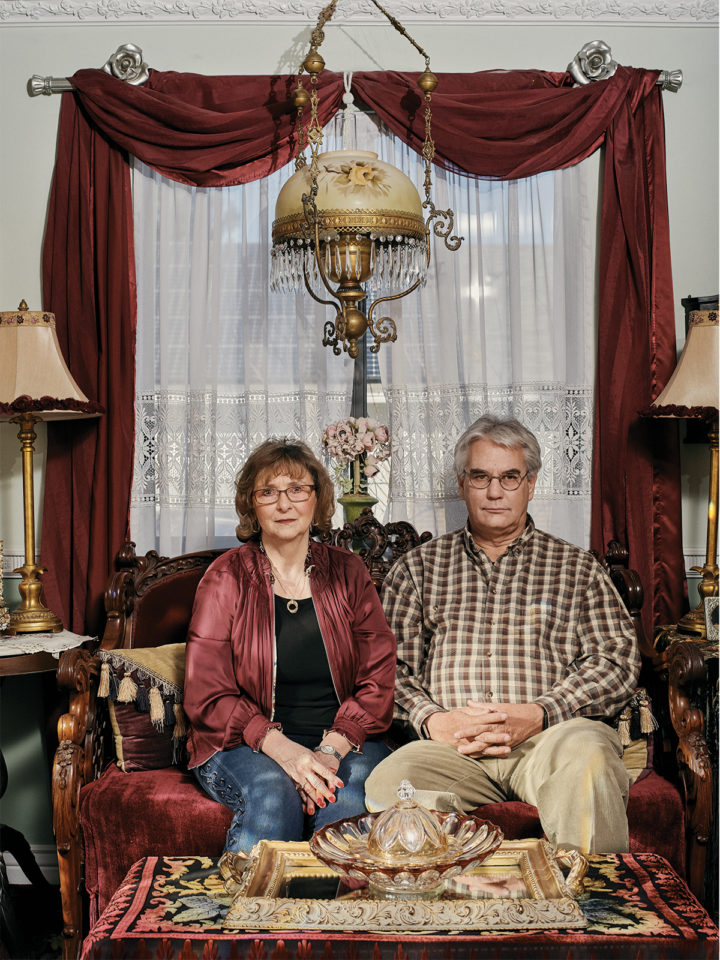
Renewal has been the unspoken commandment among everyone and everything around Columbine. The spirit of regeneration dominates here, a quiet energy that reshapes people and places—from the new businesses to the tidy two-story homes with freshly cut lawns out front. For something to be renewed, though, a terrible reality exists. First, it must have been destroyed.
To anyone from outside this community, the roads and buildings and spaces that define the boundaries of the place carry on in a disjointed normalcy. There’s the mall and the library, the thrift store and the supermarket. Yet the murders have tainted everything they touched. Invisible monuments endure. An ordinary sidewalk once was the pathway for a child’s escape; a fence was an impediment to be broken through; a driveway was a triage center; a gymnasium storage room was where boys and girls hid and prayed.
One afternoon early this year, Columbine’s principal, Scott Christy, sits in his office, which is decorated with framed photos of his family and Columbine sports teams. His window overlooks the school’s entrance. Two other men have occupied Christy’s office since April 1999, including Frank DeAngelis, who guided the school through the tragedy and became a renowned figure in his community and around the world. Christy arrived in 2009 as assistant principal and later became the school’s athletic director. After DeAngelis’ successor, K.C. Somers, retired two years ago, Christy was named principal. Today he presides over a teaching staff of about 85, of which just 18 were at the school in 1999.
“People outside this community know about us because of one moment in time,” Christy says. “But for us, this is where people work. Kids learn here, they play sports, join clubs, and meet friends. This building might be historic to a lot of people, but this is a high school for the rest of us. When I come through the front doors every morning, I’m not thinking about what happened back then. I’m thinking about what I have to do to make this a great place for the people inside it.”
He pauses, and for a moment, he drops his polished veneer. “There’s a weight here,” he says. “When you wear the word ‘Columbine’ across your chest, you can’t hide from it. There’s a responsibility with that. We will never be just about a school.”
The events of April 20, 1999, exist in a complicated space, and their aftermath is now woven into the area’s DNA. The experience among those here has been simultaneously universal and intimately singular, both visible and hidden. For those adopted into it, the memory is now secondhand, a borrowed grief. The tragedy is memorialized in books that Columbine students—none of whom were alive at the time of the murders—read in their classes.
In the days following the shooting, the funerals began: For the boy who dreamed of becoming a Navy pilot and loved the color green because it reminded him of a soccer field; for the volleyball team captain who hoped to be the school’s valedictorian; for the shy, loving kid who’d been at Columbine for only three months; for the teen who wanted to be a music executive; for the heroic teacher whose final act was saving children from gunfire.
At Trinity Christian Center, just about a mile from Columbine, Rachel Scott’s white coffin was rolled through the front doors toward a stage blanketed with flowers. Four days had passed since her murder, and more than 1,500 people packed into the church, which had once been the site of a Kmart. Nearly a dozen spoke during the Saturday service, including Rachel’s pastor and her prom date. Friends signed the girl’s coffin, covering almost every inch in black marker. Millions of people watched the funeral on CNN—the most viewers for a single televised event on that network at the time—turning the small community’s grief into a global act of mourning. Three days later, 17-year-old Corey DePooter’s coffin was brought through the same doors. “What person here can tell me that there is no such thing as evil in our world?” a pastor asked the mourners.
Trinity is gone now and has been replaced by a new church. This past year, Bruce Fosdick called about a piece of property that had become available. Fosdick had recently started Authentic Life Church, and the pastor was looking for space for his future congregation. He pulled into the parking lot of the former Kmart. “I immediately knew,” he says.
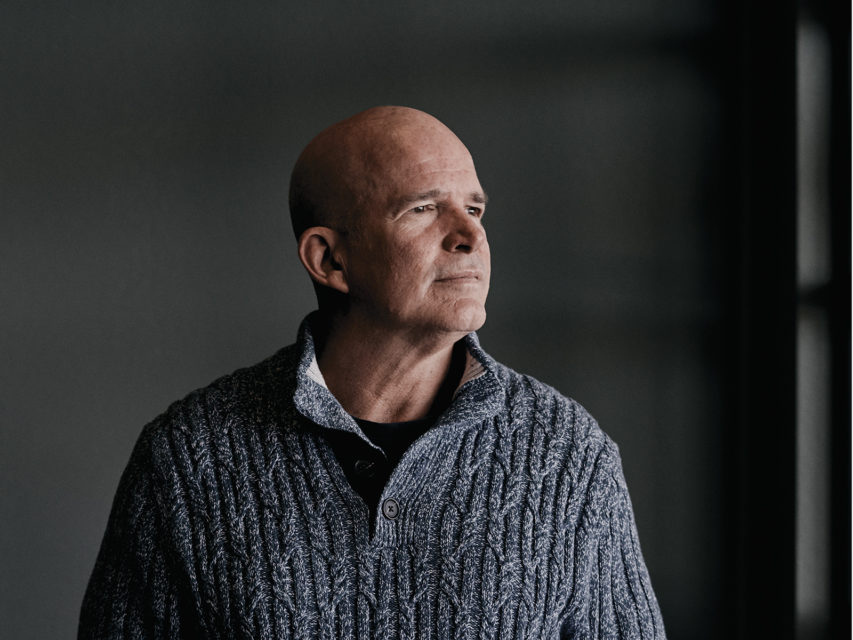
Fosdick is 56 years old. Nearly two decades ago, he and his family moved to Jefferson County from California; the Columbine shooting happened eight months before he arrived. For him, there is no Before Columbine. Everything is after.
He signed the lease in May and opened his church a few months later; now his Sunday services average 500 worshipers. Fosdick has heard about the years immediately following the funerals, how there was a weariness in the building he now occupies, a spirit of death that couldn’t be shaken. At one time, black curtains were everywhere; photos from the funerals dotted the walls. By the time Fosdick got the place, those moments had long been erased. When he walks from the church offices into the shadowy foyer these days, the pastor sees nothing of that past. “God,” he says, “gets us to move on.”
This year, though, will be different. April 20 happens to fall one day before Easter Sunday, and the symbolism is self-evident. The pastor’s already thinking about what he might say from his stage, how he might remember those who died while also celebrating the people in front of him—how he can acknowledge the lasting, inescapable damage from that single day, the complexity of their neighborhoods and their schools.
As he sits in an oversize leather chair, Fosdick sketches the words in his mind. He taps a hand on his knee as he thinks. “Resurrection, new life, hope,” he says. “A new beginning.” He considers those funerals, how he’s spent these past months building something in this place. Fosdick takes some notes and then tucks them away. “I have to wrap my mind around this properly,” he says. “We have a tendency to move on so fast, but there’s history here.”
The Friday bell chimes over the school speakers, and Scott Christy steps out of his office and into the hallway at Columbine. The principal walks past trophy cases and a plaque with the names of students who’ve scored 30 or higher on the ACT exam. The clank of metal lockers shutting for the week echoes around him. A girl gives the principal a high-five on her way toward the double doors. “Have a great weekend, guys!” he tells a cluster of teenagers.
Columbine is an old school, at least by suburban Denver standards. It was opened on a small hill above South Pierce Street in 1973, and the neighborhood surrounding it took its name from the school. Almost immediately after the murders there was conversation about this building’s future: Bulldoze it—perhaps turning the grounds into a memorial—or rebuild what was lost?
The community quickly chose the latter, and on that recent Friday afternoon, parking lots and sports fields stretch into the distance behind the school, toward the hill that overlooks Robert F. Clement Park, the scene of many post-shooting memorials. An empty Jefferson County Sheriff’s Office vehicle is parked on the sidewalk in front of the school.
Pilgrims still come to America’s most famous high school. Years ago, it was buses loaded with onlookers. Folks tried opening doors to get a peek inside or to say a prayer within the walls. Students are still asked if bullet holes are visible, if they can see the spirits of those who died. There was the elderly woman clutching a bouquet of yellow roses to lay at a doorway and the car with rental plates passing through the back lot, an outstretched arm pointing to where the library used to be. Even two decades later, sheriff’s deputies stationed at the school stop and question an estimated 400 such visitors every year.
This past fall, Jefferson County voters approved a bond to improve their schools, including Columbine. The upgrades will be among the first large-scale renovations since the new library opened in the summer of 2001. This time next year, there will be renovated locker rooms, and Christy hopes there’s money left for a new tile floor in the school’s south wing. Around 1,700 students attend Columbine today, about 300 fewer than were here during the shooting. The narrative of Columbine has always been of wealthy, white suburban kids. Although the student body today is still mostly white and middle-class, one-fifth of the school’s students qualify for free or reduced-price lunch—an indicator of poverty—more than triple the percentage in 1999.
Pilgrims still come to America’s most famous high school. Years ago, it was buses loaded with onlookers. Folks tried opening doors to get a peek inside or to say a prayer within the walls.
Just past the trophies, rows of blue lockers extend down the hallway, past a set of open doors and all the way to the back of the school. The library’s doors are open. A 10-foot-tall tablet is set on the wall to the right, the only place on the school grounds where the victims’ names are memorialized. The room is big, bright, and airy, with an exit in the back. A few students are clustered around a table. Christy spots a senior, an offensive lineman with top grades who has a chance to play big-time college football. A University of Alabama coach was at the school today.
“How did it go?” Christy asks the teenager. “Think it’s a good fit?”
They talk for a moment. Christy wishes the boy good luck and steps out of the room. Tiled into the floor directly in front of him is a large purple columbine flower and a butterfly. At one time, this section of hallway was outside the school. The flower and butterfly are near the spot where Rachel Scott died. “Most of our kids don’t know that,” the principal says. Up ahead, at a stairway that leads to a common area, there’s another large columbine on the floor, this one near where teacher and coach Dave Sanders was shot while trying to lead students to safety.
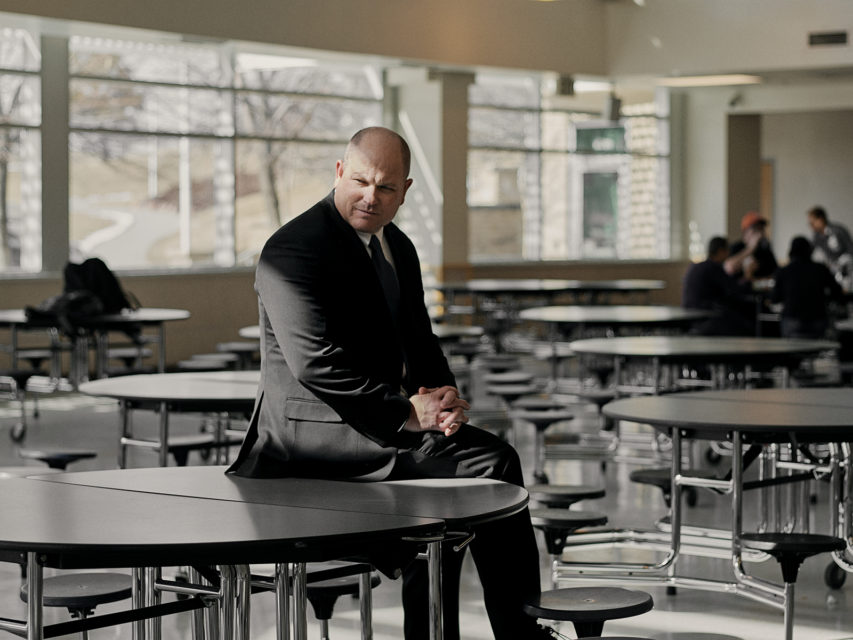
The school gives up its secrets slowly. Each new class of freshmen has what one current student calls their “Welcome to Columbine” moment. There’s the bomb threat that happens every few years and temporarily throws the school into lockdown while police investigate. Four years ago, it was the day of the homecoming dance. This school year, it was two weeks before winter break. On February 14, 2018, 17 people were murdered at Marjory Stoneman Douglas High School in Florida. That day was different around Columbine. “You could feel it,” Christy says.
A staff meeting had been scheduled for the following day, but the principal found himself second-guessing the timing. Who would want to talk about curriculum and budgets when another high school had been attacked? he thought. Christy phoned DeAngelis, who’d become a mentor and confidant. The former principal told the current one that the meeting should go on, but not as Christy had planned. “You need to check on your staff,” DeAngelis said. “These people need to look after each other.” During the meeting the next day, Christy hung back. He opened up the room to their voices. Some were depressed, others angry. After all we’ve been through, why does this keep happening? they asked. For an hour, his teachers talked through their feelings on the subject. The next morning, they went back to work.
The gym at Columbine High School is a welcoming place. Warm lighting cascades down walls, bouncing off sagging championship banners. Students climb the rows of wooden bleachers, stopping for handshakes or hugs with friends. It’s game night on South Pierce—Columbine girls basketball versus rival Chatfield High School. Hundreds of kids from both schools file through the front doors, past the sheriff’s deputy sitting in the main office, then the trophy cases and the framed eight-by-10 photos of Columbine valedictorians and sports stars of the past.
Tonight, Columbine is down five points with three minutes to go. The Rebels’ student section is riled up, standing and cheering for the home team. Across from the students, coach Greg Bolding Jr. patrols the sideline just off Columbine’s bench, imploring his point guard to hurry up.
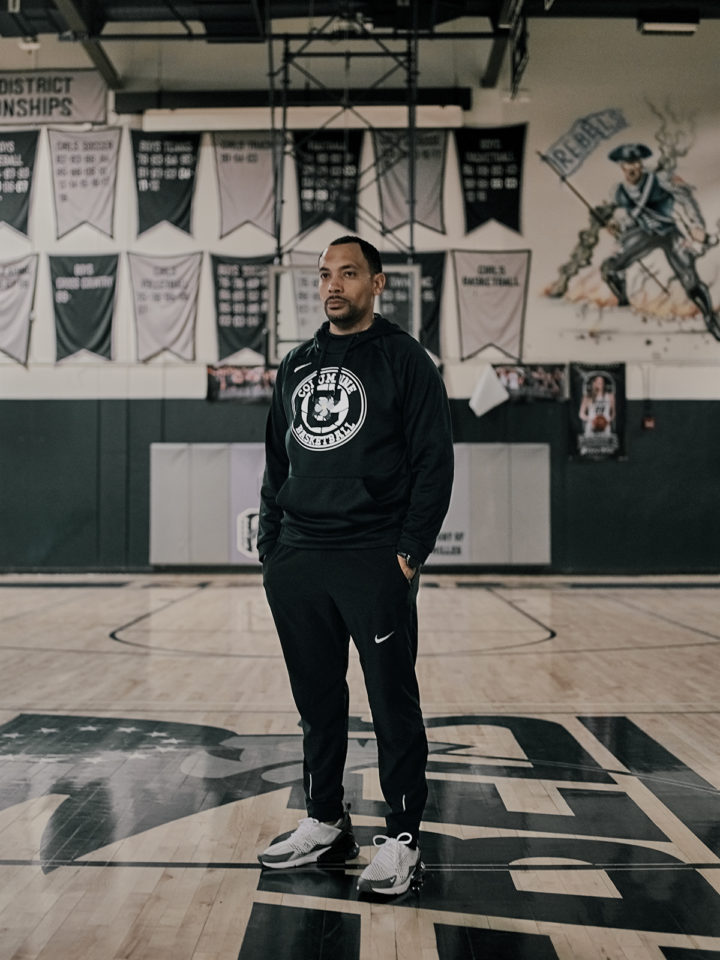
It’s his second season here. Bolding is 35, a Colorado Springs native, another adoptee into Columbine’s legacy. When he walked onto the court for his first practice, he immediately sensed the responsibility of his new job. Yes, he dreamed of making it to the state championship one day, but anyone who knows anything about Columbine knows this was once Dave Sanders’ team, which means it can never really belong to anyone else.
The coach has heard it from visiting players when they’re warming up. “It’s weird being here,” the kids say. And they’re right. Bolding once had the same feeling walking through the school’s doors, knowing something terrible happened here. And now, a basketball game is being played in this same place? Teenagers wrote their names on the choir room walls because they were sure they were about to die. The gymnasium storage room beyond the bench is where students hid.
“Hurry up! Hurry up!” Bolding hollers. “Let’s go!”
There’s a turnover, a few fouls. Columbine mounts a quick run. With time running out, Columbine misses a shot, gets a rebound but can’t put the ball in the basket. The buzzer sounds: 41-38, Chatfield. The young women line up and give each other high-fives.
Afterward, Bolding encourages his team. Before the season began, the coach had a columbine flower stitched into the hems of the team’s shorts. The white flower, he told the girls, was a symbol of strength and perseverance, of unity during times of great stress. He again tells them to remember the columbine and what it stands for.
Parents make their ways down to the court as players start heading to the locker room. Students linger in the stands for a few minutes, then file into the hallway. They pass the photos and the lockers and the trophy cases, their joyous teenage chatter filling the space. They pass the sheriff’s deputy in the main office. They press open the school’s doors and step into the night, laughing in the darkness.
Beth Nimmo isn’t sure what will happen to Rachel’s car when she’s gone. For years, she kept letters, stuffed animals, drawings, and paintings, and now they are threatening to overrun her basement. She’s beginning to pare down, because 20 years is a long time to hold on to everything. A couple of months ago, Beth went down the stairs with her daughter Bethanee and looked through the bags and boxes that covered the floor. It seemed like they were down there for hours, looking through bag after bag after bag. Beth couldn’t figure out what should go. “Maybe later,” she finally told her daughter.
It’s the same with the car. Maybe it could be part of a museum one day, she thinks. Maybe it will go to Craig, Beth’s oldest son, who escaped the library on April 20, 1999, only to find himself lost for years amid hatred and grief.
“I’m sure he’d want it,” Beth says.
The power-steering hose leaks, the tape deck no longer works, and the air conditioning overheats in the summer. The gray leather in the back seat has split along the seams. There are 163,576 miles on the engine. But Beth and Larry still keep the car in the garage. They pay the insurance on it every six months. They renew the license plates every September.
“This was Rachel’s last little thing,” Beth says, rummaging through the glove box, pulling out the folded insurance paperwork. “Boy, she loved this car.”
“It certainly was special to her,” Larry says, wiping a hand across the rear bumper.
Beth returns the insurance paperwork to the glove box. She puts a hand on the steering wheel, she touches a floor mat. She watches Larry get into the Acura, turn on the ignition, and slowly back the car into the garage.
This story is part of 5280 Magazine’s special issue dedicated to the 20th anniversary of Columbine. Read more about the project here.
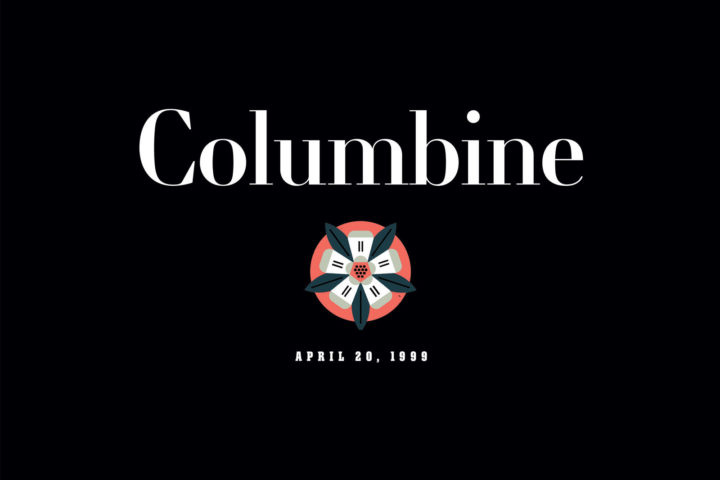
NEXT: In Memoriam
We Are All Columbine.

